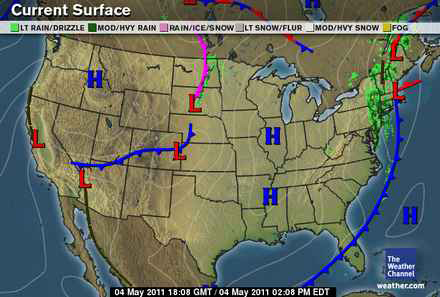Annual Evaluation: Please Share Your Thoughts
 |
Dr. David Aborn |
May 4, 2011
Dear
Students:
What happened to spring??? It was warming up nicely over much of the
country, but the past few days Mother Nature has taken a step backwards!
I was enjoying 80-degree weather, and now it is back into the 60’s
during the day (which is still pleasant) and 40’s at night.
North
winds and BIRDS!
After
all these weeks, you should know that cold temperatures mean northerly
winds, and northerly winds mean birds, birds, birds! At the beginning
of the week, when the front passed through the western Gulf Coast,
the strong north winds forced many birds to land. Along the Texas
coast,
People were seeing large numbers of Gray Catbirds, Northern Waterthrushes,
Ovenbirds, Indigo Buntings, and Dicksissels (a very pretty type of
sparrow). In Louisiana, catbirds were also numerous, along with
Eastern kingbirds.
Before that front came through, southerly winds allowed many birds from the previous week to head northward. Birders in Michigan were treated to Northern Parulas, Northern Waterthrushes, Ovenbirds, and Nashville Warblers. One birder in Belle Isle, Michigan reported a large movement of swallows, tallying 137 Tree Swallows, 125 Barn Swallows, and 95 Northern Rough-winged Swallows! Minnesota recorded its first Black-and-white Warblers and Northern Waterthrushes.
 |
Before
the front moved into the eastern US yesterday and today, migrants
were also making steady progress
north,
with Veerys, Indigo Buntings, Orchard Orioles, Magnolia Warblers,
Chestnut-sided Warblers, and Cape May Warblers being seen in Washington,
DC, Kentucky
Warblers, Blackpoll Warblers, Balckburnian Warblers, and Veerys
showing
up in Massachusetts, and Ruby-throated hummingbirds, Black-throated-blue
Warblers, and Baltimore Orioles making at far north as Vermont
and New Hampshire. You may have noticed that Northern Waterthrushes
are being
reported from many places. The situation is the same here in
Tennessee. Over the past week I have banded 8 of them, and I had only
banded
2 here in the previous 7 years! I am not sure why they are so
numerous this
spring. It could be that they produced a lot of young last year,
so
there are more returning this year. It is also possible that
reproduction was
normal, but more birds survived the winter. Whatever the reason,
they are nice to see! The thrushes have also moved into this area,
and I
caught my first Swainson’s Thrush of the year this morning.
Gray Catbirds are also increasing.
There has been a lot of migration going on out West. Southerly
winds over the weekend helped produce a large movement of birds
through
San Diego. One birder recorded 80 Western Kingbirds, 60 Wilson’s Warblers,
60 Western Tanagers, 40 Townsend’s Warblers, 35 Orange-crowned
Warblers, 25 Black-throated-gray Warblers, and 25 Warbling Vireos!!!
People in New Mexico were also reporting good numbers of Wilson’s
Warblers, along with Gray Flycatchers, Western Tanagers, and Plumbeous
Vireos. Farther north, Nashville Warblers, Orange-crowned Warblers,
Black-headed Grosbeaks, Rufus hummingbirds, Black-chinned Hummingbirds,
and Calliope
Hummingbirds were common sights in Oregon, as were Calliope Hummingbirds
and Lazuli Buntings in Idaho.
How
Does This Week Look?
Here's the map:
 |
-
In the eastern US, strong northerly winds will keep birds grounded for a couple of days, so what you see is what you get! You get to enjoy all the birds I just mentioned for a couple of days until the high pressure moves off the east coast. At that time, those birds will head north, and the next wave of migrants will come through.
-
In the Midwest, winds have already shifted, so all those birds reported in Texas and Louisiana will be headed your way!
-
Farther west, another front is coming in from the Rockies. It is not very strong right now, but it may be enough to halt migration for a day or two, especially with the high pressure sitting over the Northwest. As the front moves eastward, winds will shift by the weekend, and any migrants still in the tropics will have favorable conditions for reaching the southwestern US.
-
For people in the southern part of the US, migration is past its peak and will start to decline. If you live farther north, migration is just hitting its stride, and you have a few more weeks of new birds coming into your area. Then you get to enjoy all the colors and songs for the whole summer before the birds begin their epic journey back to the tropics.
Costa Rica, Here I Come
Next
week I will be in the one of the places some of the birds just came
from and where
they may return to in the fall:Costa Rica!
It is a wonderful place, and I hope some of you have the chance to
go there sometime. Incredible wildlife (including over 800 species of birds!!!),
nice people, great food; you can’t go wrong! This semester I
have been teaching a class on Tropical Ecology, and what better way
to help
them understand what they have (hopefully) learned than to take them
to the tropics. We will spend several days at Selva
Verde Lodge studying
a lowland rainforest, and then we go to Savegre
Mountain Lodge
to look at a cloud forest.
I was in Costa Rica in 2004 and had a fabulous time, and I anticipate
an
equally good trip this year.
My Wish for You
Whether
you go to a tropical paradise or stay in your own neighborhood, I hope
you have a great summer! If
you
have any questions about my reports, birds, or migration, feel free
to ask me.
Take
Care.
David Aborn
North
Chickamauga Creek Conservancy
Chattanooga, TN
| Annual Evaluation: Please Share Your Thoughts | |
Will you take a few minutes to complete our Year-end Evaluation? With your help, we can document Journey North's reach, impact and value. We need comments like yours to keep the program going and growing.
|
 |


